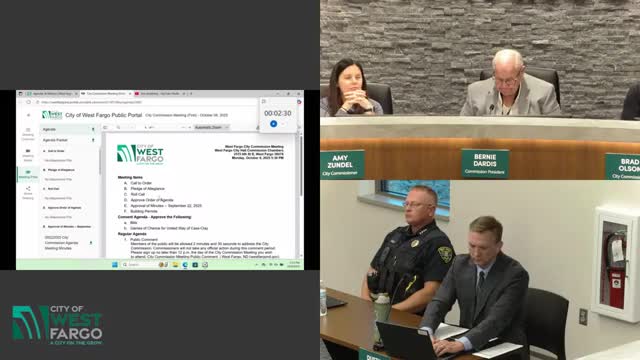West Fargo City Commission Approves Hope Lutheran Church Rezoning with Access Conditions
October 07, 2025 | West Fargo, Cass County, North Dakota
This article was created by AI summarizing key points discussed. AI makes mistakes, so for full details and context, please refer to the video of the full meeting. Please report any errors so we can fix them. Report an error »

In the heart of West Fargo, community members gathered at the City Commission meeting on October 6, 2025, to discuss a significant development project that has stirred both excitement and concern among residents. The proposed expansion of Hope Lutheran Church, which has been a cornerstone of the community for nearly three decades, is set to transform the neighborhood, but not without raising questions about traffic and neighborhood dynamics.
Jobe Lickblau, the church council president, opened the discussion with a heartfelt appeal, thanking the commissioners for their dedication to the community. He acknowledged the concerns raised by neighbors regarding the church's plans but emphasized the church's commitment to being a positive presence in West Fargo. Lickblau highlighted that the church has adhered to all city guidelines and worked closely with city staff to ensure compliance with zoning and safety regulations. He pointed out that the traffic study conducted for the project indicated that the church would generate less daily traffic than a typical residential development, a fact he hoped would alleviate some fears.
Brian Berg, the project architect, further clarified the findings of the traffic study, noting that events such as weddings and funerals, while significant to the church's mission, occur infrequently and would have minimal impact on local traffic. He argued that the proposed church would not only serve its congregation but also strengthen community ties, providing a space for compassion and connection.
However, not all voices echoed this optimism. Joshua Crank, a local resident, raised concerns about the potential traffic increase on Sixth Street, a quiet residential road. He pointed out that while the overall traffic impact might seem moderate, the reality for residents on that street could be quite different, especially during peak church events. Crank suggested that the commission reconsider the church's location, given that city utilities would soon be available at an alternative site.
Mike Meschewski, another resident, expressed strong opposition to the proposed access point from the church onto Sixth Street. He argued that the current traffic estimates were overly optimistic and that the addition of a church would fundamentally change the character of the street, which currently sees only 150 vehicles a day. Meschewski emphasized the need for pedestrian safety and raised concerns about the multi-use nature of church facilities, which could lead to increased traffic and safety issues in the residential zone.
As the meeting progressed, it became clear that the proposed expansion of Hope Lutheran Church is not just a matter of building a new facility; it is a reflection of the community's evolving identity and the balancing act between growth and preserving the character of established neighborhoods. The City Commission now faces the challenge of weighing the benefits of the church's expansion against the concerns of local residents, a decision that will shape the future of West Fargo for years to come.
Jobe Lickblau, the church council president, opened the discussion with a heartfelt appeal, thanking the commissioners for their dedication to the community. He acknowledged the concerns raised by neighbors regarding the church's plans but emphasized the church's commitment to being a positive presence in West Fargo. Lickblau highlighted that the church has adhered to all city guidelines and worked closely with city staff to ensure compliance with zoning and safety regulations. He pointed out that the traffic study conducted for the project indicated that the church would generate less daily traffic than a typical residential development, a fact he hoped would alleviate some fears.
Brian Berg, the project architect, further clarified the findings of the traffic study, noting that events such as weddings and funerals, while significant to the church's mission, occur infrequently and would have minimal impact on local traffic. He argued that the proposed church would not only serve its congregation but also strengthen community ties, providing a space for compassion and connection.
However, not all voices echoed this optimism. Joshua Crank, a local resident, raised concerns about the potential traffic increase on Sixth Street, a quiet residential road. He pointed out that while the overall traffic impact might seem moderate, the reality for residents on that street could be quite different, especially during peak church events. Crank suggested that the commission reconsider the church's location, given that city utilities would soon be available at an alternative site.
Mike Meschewski, another resident, expressed strong opposition to the proposed access point from the church onto Sixth Street. He argued that the current traffic estimates were overly optimistic and that the addition of a church would fundamentally change the character of the street, which currently sees only 150 vehicles a day. Meschewski emphasized the need for pedestrian safety and raised concerns about the multi-use nature of church facilities, which could lead to increased traffic and safety issues in the residential zone.
As the meeting progressed, it became clear that the proposed expansion of Hope Lutheran Church is not just a matter of building a new facility; it is a reflection of the community's evolving identity and the balancing act between growth and preserving the character of established neighborhoods. The City Commission now faces the challenge of weighing the benefits of the church's expansion against the concerns of local residents, a decision that will shape the future of West Fargo for years to come.
View full meeting
This article is based on a recent meeting—watch the full video and explore the complete transcript for deeper insights into the discussion.
View full meeting
